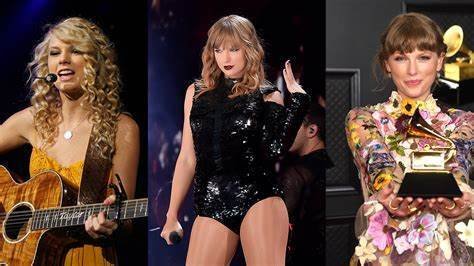(aesthetic:qgijenkfgs4= taylor swift) Taylor Swift’s aesthetic evolution is as dynamic as her career. From her country roots to her transformation into a global pop icon, Swift’s visual representation has mirrored her personal and musical growth. This article delves into the various stages of Taylor Swift’s aesthetic, showcasing how her style has influenced and reflected her musical journey.
2. The Early Country Aesthetic
(aesthetic:qgijenkfgs4= taylor swift) Swift burst onto the scene in the mid-2000s with a country aesthetic characterized by sundresses, cowboy boots, and soft curls. This early image resonated with her young audience and aligned with the themes of her debut album, Taylor Swift, which focused on teenage love, heartache, and small-town life.
3. Fearless: Glamour with a Country Twist
(aesthetic:qgijenkfgs4= taylor swift) With her second album, Fearless, Swift maintained her country roots but began incorporating more glamorous elements. Her iconic curly hair and sparkly dresses became synonymous with her image during this era. This aesthetic complemented her transition to a more mainstream sound while retaining her country-pop charm.
4. Speak Now: The Fairy-Tale Era
(aesthetic:qgijenkfgs4= taylor swift) During the Speak Now era, Taylor Swift embraced a romantic, fairy-tale aesthetic. Flowing gowns, whimsical sets, and storybook-like visuals dominated her music videos and performances. This era saw Swift exploring more complex narratives in her music, and her visual representation mirrored this growth.
5. The Red Era: A Bold New Look
(aesthetic:qgijenkfgs4= taylor swift) Red marked a significant shift in Swift’s aesthetic. With her signature red lipstick, sleek bangs, and more mature fashion choices, Swift embraced a bolder, more modern look. This aesthetic change reflected the emotional complexity of the album, which explored themes of heartbreak, love, and identity.
6. 1989: The Birth of the Pop Icon
(aesthetic:qgijenkfgs4= taylor swift) With 1989, Taylor Swift fully transitioned into the pop genre, and her aesthetic followed suit. She adopted a sleek, chic, and polished look, characterized by crop tops, high-waisted skirts, and retro-inspired outfits. Her music videos during this era, particularly “Blank Space” and “Style,” showcased a high-fashion, editorial aesthetic that aligned with her newfound pop identity.
7. Reputation: Dark and Edgy
(aesthetic:qgijenkfgs4= taylor swift) The Reputation era marked one of the most dramatic shifts in Taylor Swift’s aesthetic. She adopted a darker, edgier style, with black outfits, bold makeup, and a more intense visual tone in her music videos. This era was a response to public controversies and media scrutiny, and Swift used her aesthetic to reflect the themes of empowerment and rebirth.
8. Lover: Pastel Dreamland
(aesthetic:qgijenkfgs4= taylor swift) In contrast to the darkness of Reputation, Lover brought a softer, pastel-colored aesthetic. Swift embraced bright colors, whimsical visuals, and a playful, romantic style. The Lover era reflected a more optimistic and joyful outlook, focusing on themes of love, self-acceptance, and happiness.
9. Folklore: A Shift to Indie Folk Aesthetic
(aesthetic:qgijenkfgs4= taylor swift) Folklore marked a stark departure from Swift’s previous aesthetics. Embracing an indie folk aesthetic, she adopted a more natural, muted style. Earth tones, cozy sweaters, and rustic imagery dominated her music videos and album visuals. This era saw Swift focusing more on storytelling, and the stripped-down aesthetic matched the introspective and reflective nature of the music.
10. Evermore: A Continuation of Folklore
(aesthetic:qgijenkfgs4= taylor swift) Following Folklore, Swift released Evermore, which continued the indie folk aesthetic. The visuals remained understated, with a focus on natural landscapes, vintage-inspired clothing, and minimalistic styling. This era solidified Swift’s place in the indie-folk realm, showcasing her versatility as an artist.
11. The Role of Fashion in Taylor Swift’s Aesthetic
(aesthetic:qgijenkfgs4= taylor swift) Fashion has always played a crucial role in Taylor Swift’s aesthetic evolution. From glamorous gowns to casual street style, Swift’s fashion choices have often mirrored her musical transitions. Her style has influenced trends and inspired countless fans, cementing her status as a fashion icon.
12. Hair as an Expression of Identity
(aesthetic:qgijenkfgs4= taylor swift) Taylor Swift’s hair has been a key element of her aesthetic throughout her career. Her signature curls defined her early country days, while her sleek, straight bob during the 1989 era signified her pop transformation. Each hairstyle has symbolized a new chapter in her musical and personal journey.
13. Music Videos: A Visual Representation of Her Aesthetic
(aesthetic:qgijenkfgs4= taylor swift) Swift’s music videos have been instrumental in shaping her aesthetic. Each video serves as a visual representation of the themes and emotions of her songs. From the whimsical fairy-tale worlds in Speak Now to the bold, cinematic visuals in Reputation, her music videos have been a vital component of her artistic expression.
14. Taylor Swift’s Aesthetic Influence on Pop Culture
(aesthetic:qgijenkfgs4= taylor swift) Taylor Swift’s aesthetic has had a significant impact on pop culture. Her fashion choices, music videos, and overall visual representation have influenced trends and inspired other artists. From the “Swiftie” fanbase mimicking her style to the broader fashion industry, Swift’s aesthetic has left a lasting mark.
15. The Use of Symbolism in Swift’s Aesthetic
(aesthetic:qgijenkfgs4= taylor swift) Swift is known for incorporating symbolism into her aesthetic, especially in her music videos and performances. From subtle references to her personal life to visual metaphors in her storytelling, Swift uses her aesthetic as a tool to communicate deeper meanings to her audience.
16. Color Palettes and Their Significance
Color has played a significant role in Taylor Swift’s aesthetic evolution. Each era is often defined by a specific color palette that reflects the mood and themes of her music. For instance, the dark tones of Reputation contrasted sharply with the pastel colors of Lover, signaling a shift in tone and narrative.
17. The Impact of Social Media on Taylor Swift’s Aesthetic
Social media has allowed Taylor Swift to curate and control her aesthetic in real time. Through platforms like Instagram and Twitter, she shares behind-the-scenes glimpses of her life and creative process, allowing fans to see how her aesthetic is crafted. Swift’s use of social media has also allowed her to engage directly with her audience, making her aesthetic more accessible to fans.
18. How Swift Uses Live Performances to Elevate Her Aesthetic
Swift’s live performances are an extension of her aesthetic vision. From elaborate stage designs to carefully chosen costumes, each concert is a reflection of the current era’s theme. Swift’s ability to translate her aesthetic into a live setting has made her one of the most dynamic performers in the music industry.
19. Collaborations with Designers and Artists
Throughout her career, Swift has collaborated with various designers and artists to shape her aesthetic. From working with top fashion designers to partnering with directors and photographers for her music videos, these collaborations have helped bring her vision to life.
20. The Role of Album Artwork in Defining Her Aesthetic
Album artwork has been a central component of Swift’s aesthetic. Each album cover serves as a visual representation of the music within, offering fans a glimpse into the themes and emotions explored in the songs. The evolution of her album covers reflects the shifts in her musical and personal journey.
21. The Importance of Authenticity in Swift’s Aesthetic
Despite the changes in her aesthetic over the years, one thing that has remained consistent is Swift’s authenticity. Each aesthetic shift has been a reflection of her personal growth, making her evolution feel genuine and relatable to her fans. This authenticity has helped Swift maintain a loyal fanbase throughout her career.
22. How Taylor Swift’s Aesthetic Connects with Her Lyrics
Swift’s aesthetic is deeply connected to her lyrical content. The visuals she creates often mirror the stories and emotions conveyed in her songs. For example, the dreamy, romantic visuals of Lover aligned perfectly with the album’s themes of love and happiness, while the darker visuals of Reputation reflected the album’s themes of revenge and empowerment.
23. The Fanbase’s Role in Shaping Taylor Swift’s Aesthetic
Swift’s fanbase, known as “Swifties,” has played a significant role in shaping and embracing her aesthetic. Fans often adopt Swift’s fashion choices, hairstyles, and visual trends, creating a symbiotic relationship between the artist and her audience. This connection has strengthened the bond between Swift and her fans, making her aesthetic more impactful.
24. The Future of Taylor Swift’s Aesthetic
As Taylor Swift continues to evolve as an artist, it’s exciting to speculate about the future of her aesthetic. With each new album, Swift reinvents herself visually and musically, leaving fans eager to see what she will do next. Whether she returns to her country roots or explores new genres, her aesthetic will undoubtedly continue to evolve.
25. Conclusion: Taylor Swift’s Ever-Evolving Aesthetic
Taylor Swift’s aesthetic journey is a testament to her growth as an artist and individual. From her country beginnings to her status as a global pop icon, Swift has used her aesthetic to communicate her personal and artistic evolution. As she continues to push boundaries and reinvent herself, her aesthetic will remain an integral part of her legacy in the music industry.







